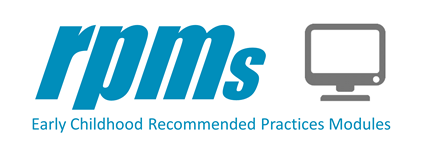Module 2 Learning Guides
These guides are used by and facilitated by instructors with learners. They are designed to extend the learning in the self-paced modules.
General Guides
- For Instructors: RPM Learning and Improvement Framework
- Embedding the Modules into Existing Coursework and Practicum
- Introduction to the RPM Crosswalks
- Transition Crosswalk
Learning Guides
Guide Name and Description/Objectives |
Related Lesson/Module Section |
| PLAN SECTION | |
|
Learning Guide 2.1: Setting the Stage- Pre-Module With this guide, learners will:
|
Setting the Stage (3:13 run time) You will meet Natasha and Ben with their son, Silas who is transitioning from neonatal intensive care to home. |
|
Learning Guide 2.2: Ask The Expert With this guide, learners will:
|
Lesson 1: Ask the Expert (2:52 run time) Transition is defined and the best available research on transition practices is summarized by Dr. Beth Rous. |
|
Learning Guide 2.3: Role of the Practitioner With this guide, learners will:
|
Lesson 2: Gathering the Information (16:29 run time) Strategies on how to best exchange information effectively with other practitioners are explained with examples and activities. |
|
Learning Guide 2.4: Continuity and Alignment With this guide, learners will:
|
Lesson 3: Planned and Timely Strategies (19:36 run time) Key planned and timely strategies that can be used to support children and families transitioning between programs, are explained with examples and activities. |
|
Learning Guide 2.5: Voices from the Field With this guide, learners will:
|
Lesson 4: Voices from the Field Practitioners and family leaders share their expertise and perspectives of using interaction practices with young children. |
| DO and STUDY SECTIONS | |
|
Learning Guide 2.6: Scenario-Based Activity This guide contains a set of five simulations/scenarios that can be used in place of, or in addition to, the online simulation. With this guide:
Learning Guide 2.7: Reframing Activity Guide With this guide:
Learning Guide 2.8: Planned and Timely Strategies Table Transition practices are an intentional set of activities that promote communication between sending and receiving practitioners, engage families in collaborative planning, and support the preparation and adjustment of children and families to a change in settings or programs. Learning Guide 2.9: Practice Dilemmas With this guide, learners will:
|
|
| ACT SECTION | |
|
Learning Guide 2.10: Performance Feedback Guide This guide can be used to debrief with learners following their participation in a transition for a child and family in either their own classroom/setting/program or in field-experiences associated with university coursework. Learning Guide 2.11: Practice Profile Transition practices are an intentional set of activities that promote communication between sending and receiving practitioners, engage families in collaborative planning, and support the preparation and adjustment of children and families to a change in settings or programs. Learning Guide 2.12: Setting the Stage- Wrap-Up With this guide, learners will:
|
Module 2 Act Section |
Got questions? Looking for SCORM-ready lessons to embed in your LMS? Contact rpm@unc.edu
